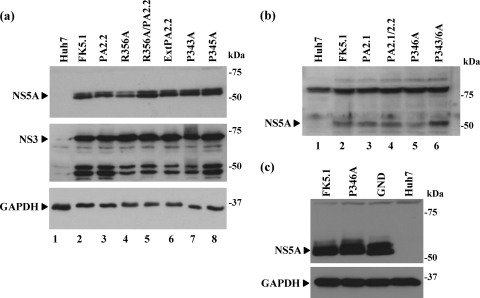FIG. 3.
Expression of HCV nonstructural proteins by PP2.1/2.2 motif mutant replicons. (a) Analysis of stable polyclonal cell populations. Polyclonal populations of cells transfected with the indicated replicons were maintained in the presence of G418 (500 μg/ml). Cell lysates were analyzed by Western blotting with polyclonal antisera to NS5A (17) or NS3 (1) or a monoclonal antibody to GAPDH (glyceraldehyde-3-phosphate dehydrogenase), followed by the appropriate horseradish peroxidase-conjugated secondary antibodies (Sigma) and enhanced chemiluminescence. The appropriate bands for NS5A, NS3, and GAPDH are indicated (▸), the lower-molecular-mass bands in the NS3 blot represent proteolytic degradation products. Lane 1 is a lysate from control, untransfected Huh7 cells. (b) Analysis of input RNA translation of replication-incompetent replicons. For replicons that did not establish G418 resistant cell clones, Huh7 cells (106) were transfected with 2 μg of RNA and harvested at 4 hpt. Lysates (20 μg of protein) were analyzed by Western blotting with a polyclonal antisera to NS5A. The NS5A-specific band is indicated (▸); the higher-molecular-mass band is a cellular protein that cross-reacts with the NS5A antiserum and is always detected upon extended exposure of Western blots. (c) Huh7 cells were infected with vTF7-3 (8) (10 PFU/cell) and transfected with the indicated replicon plasmid DNAs. At 22 h postinfection lysates (10 μg of protein) were analyzed by Western blotting for NS5A or GAPDH.

